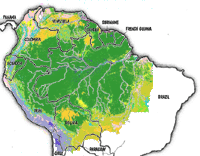
| Global warming occurs every one hundred thousand years, and persists for about fifteen thousand years. We are now near the end of a warm period. The normal condition for millions of years has been mile-thick ice over north America, Europe and Asia, broken by brief warm spells, when the ice melts. |
| During the last 475,000 years, five warm periods have occurred, each about 15,000 years long, and each separated by about 100,000 years of ice, depicted in the schematic below: |
 |
|
|
| The maximum temperature variation represented above between hot and cold is about ten degrees centigrade. The length of both the glacial and interglacial periods varies somewhat, and there are shorter temperature perturbations not shown here, that do not affect the ice mass significantly. Wisconsinan is the name of the previous glacial advance that reached a maximum about 20,000 years ago. About 50,000 years ago, during the Wisconsin, aboriginal man migrated along the southern coasts of Asia, avoiding the ice, and probably subsisting on shell fish. Modern civilization has developed during the period of retreating ice in the last 10,000 years. When discussing the affects of human civilization on global temperatures, the fact that we are at the end of an interglacial period (at the end of a warm spell) must be considered. Nature might make a sudden change due to unknown factors, but that’s an unlikely gamble, considering the records from the past 36 million years. The question becomes -- can human activity save the civilized world from the mile-thick ice sheets? This question never comes up during global warming discussions on news and science programs or in articles. No scientist is yet boasting about how the world has been saved from the ice by humans. Most likely humans have had little affect on nature’s plans. The sun is currently warming the Southern Hemisphere and cooling the Northern Hemisphere. As mountain glaciers in the south melt, the deserts migrate northward and the moisture moves ever northward, eventually to fall as snow. As the ocean’s conveyor currents slow, less cold water flows south, and the equatorial waters warm, as is occurring now. As the evaporation at the equator increases, the moisture is carried towards the poles where it falls as snow, as is happening in north central Greenland, and in central Antarctica. According to the ice core records, the temperature has been falling in north central Greenland for perhaps the last 2000 years. The glaciers have been melting for the past 10,000 years. Suddenly some scientists are alarmed, and think man has influenced nature. A news program recently showed the ice melting in southern Greenland, but never mentioned the increasing ice in north central Greenland. Imperfect computer simulations show man is heating up the planet, but the ice cores from north central Greenland show the temperature is falling. The global warming scientists had better be right, that the planet is warming. When the ice advances, the Northern Hemisphere becomes a sand-and-gravel wasteland. The only place green trees remain is in the Carolinas and Georgia. Earth’s 6 billion inhabitants, or more likely 9 billion, will eat all the clams in a few hours, then they’ll have to eat each other (as has happened many times in periods of scarcity). The global warming scenarios aren’t good either. The Earth was much warmer 5,500 years ago, during what was called the Holocene maximum. Then the Great Plains dried up into a desert, the Mississippi river slowed to a trickle, and the extant long horn bison went extinct. The 1930’s dust bowl was just a sample. Man certainly didn’t cause the Holocene maximum. The Earth has been cooling ever since, with minor fluctuations. The greenhouse gas carbon dioxide has been up to 18 times higher in the distant past also, due to no fault of mankind. The question is are we being destroyed by greenhouse gases, or being saved, or is there no affect on nature’s course? Keep an open mind. The amount of two greenhouse gases, carbon dioxide and methane, closely follow the above temperature schematic: the gases rise during the warm spells and drop during the cold spells. Rising greenhouse gases should be expected right now. During the late Ordovician Period, 475,000,000 years ago, carbon dioxide levels were 12 times higher than today, but global temperatures were 10 degrees C colder than today. Because of copyright considerations, I did not include plots of Earth’s temperatures here. Some sources where to find them: Martin J. Seigert, “Ice Sheets and Late Quaternary Environmental Change”, p. 2, 15, 17. John D. Cox, “Climate Crash”, p. 115. Harm de Blij, “Why Geography Matters”, p. 83. My name is Hank Harrell. I am not a paleoclimatologist (I’m a mechanical engineer, Union College ‘59). I have no connection to either big oil or environmental groups, and no political persuasions. I’m a nature lover, hiker, and ocean sailor. The scientists seem reluctant to voice their opinions. What I want to provide is a counterpoint to the almost fraudulent articles and programs about global warming, that never mention the facts. They show starving polar bears and melting ice, and blame it on humans. We can hope it’s caused by humans, because that will mean humans can control nature. It will mean we can stop the 360 foot rise and fall of the oceans and stop the millions of cubic miles of ice formation. Likely? Or not likely? I would like to apologize to all the scientists here for not using the proper definition of global warming and climate change. I think “hot” and “cold” will suffice for this work. Why isn’t our government concerned for this threat to the human race? And why is NASA planning a trip to Mars, when civilized Earth is in danger? The billions of dollars should be spent on climate research and a survival plan. |


